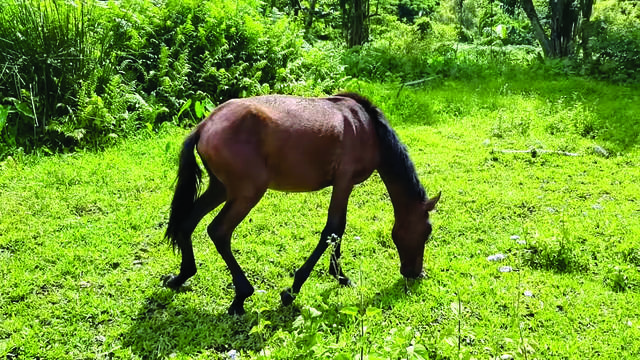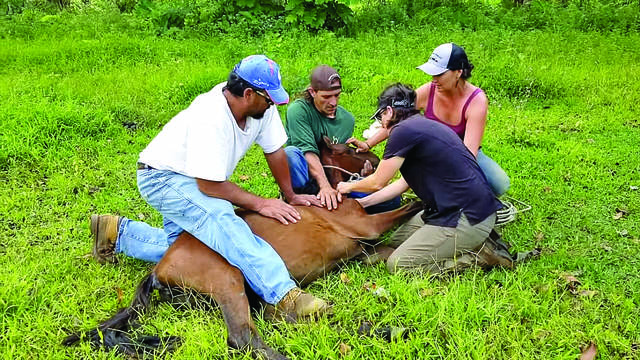KAILUA-KONA — A battery of tests now done, several veterinarians from across Hawaii and the country are still unable to pinpoint the deadly malady that claimed the lives of 13 wild horses in Waipio Valley between June and July.
In a Friday release from the Hawaii Department of Agriculture, veterinarians were able to determine that no infectious disease of any sort was the perpetrator and “…that the incident may be attributed to possible exposure to a toxicological event.”
Kelleyerin Clabaugh, who was initially contacted by horseback tour operators in Waipio Valley concerned about contagion and was the first veterinarian to begin investigation of the mysterious deaths, told West Hawaii Today in July she was suspicious of a toxic culprit even before extensive testing had been completed.
Veterinarians from the HDOA, the University of Hawaii at Manoa College of Tropical Agriculture and Human Resources, and local vets like Clabaugh and Tim Richards, also a county councilman, took part in the investigations that followed.
Richards, who is also a rancher and has worked with large animals for years, examined a wild horse the HDOA euthanized before sending off samples for testing. He told the newspaper in July he’d never seen anything like the symptoms the horses presented — weakness in the hind limbs that led to muscle atrophy, an abnormal gait and, ultimately, an inability to stand.
University of Hawaii at Hilo College of Pharmacy researchers and veterinary toxicologists and pathologists from the mainland also tested for a variety of potential neurological causes, only to come up empty, the release said.
“This disease investigation into the cause of the deaths of these wild horses is one of the most extensive in Hawaii in my recollection,” Jason Moniz, DVM and manager of HDOA’s Animal Disease Control Branch, said in the release. “In addition to the veterinarians, laboratories and researchers who worked on this case, we appreciate the help of Waipio Valley taro farmers who provided assistance, observations, information and feedback and who showed sincere concern for these horses.”
Infectious equine diseases were negative, the release continued.
“Equine pathologists found mild inflammation of the horse’s brain, but it was not deemed significant enough to cause the deaths,” the release read. “Two small lesions found in the spinal cord appeared old and were also determined insufficient to cause significant neurologic disease or death.”
Social media went wild in the aftermath of the announcement that horses in Waipio Valley were dying, as many speculated rat lungworm disease might be the culprit.
State House Rep. Richard Creagan, a medical professional who represents areas of South Kona, North Kona and Ka‘u, noted that vets are finding the disease is a lot more prevalent in animals than previously thought.
While evidence of rat lungworm was present in test results, investigators concluded the damage to the horse’s brain and spinal cord couldn’t be reliably attributed to an active rat lungworm infection.
There was also reportedly a small hydraulic fluid spill in the region of Waipio Valley the affected horses were known to populate, and depressed nerve tissue enzymes lent credence to the idea that this could have contributed to the horses’ deaths. Such a depression is possible after organophosphate exposure or exposure to a variety of insecticides and other chemicals.
While organophosphates are present in some hydraulic fluids, investigators ruled out this possibility upon microscopic evaluation of the horse’s nerve tissue.
The release said that muscle and fat atrophy indicated parasites found in the wild horse’s intestines may have contributed to its malnourished appearance. However, they wouldn’t explain other clinical signs arising from the still-mystery source of the animals’ atrophy and death.
Liver and muscle damage consistent with the parasitic presence in the horse’s intestines was discovered via blood tests. Investigators will administer further tests to check on the nature of Sarcocystis spp., a microscopic parasite that was found in some of the horse’s muscles, “so its significance can be determined.”
If toxins do prove to be the issue, veterinarians have been unable to determine their source.
“There are a number of plants growing in Waipio Valley that are toxic to horses and other animals,” the release read. “However, no toxins were detected in the stomach content or liver of this horse. In addition, plants with toxic principles grow throughout the valley and not only in the area where the affected horses resided.”
Those who frequent the valley guess that around 50-60 wild horses roam there in five distinct groups, or bands. The horses that fell ill were part of the same band that inhabited a portion of the west side of the valley, according to HDOA.
Neither horses from other bands nor domestic horses maintained by tour companies came down with similar symptoms.
HDOA asks that the public report to the State Veterinarian’s office any other health problems they notice in horses that populate Waipio Valley. The office can be reached at (808) 483-7100.
A detailed report of tests and findings is available online at https://hdoa.hawaii.gov/ai/main/wildhorses.










What about exposure to toxic waste from a meth lab?
some sort of neurotoxin. I had to put my dog down because of that type of poison. Lost use of hind legs, couldnt stand or walk. Vet identified general neurotoxin but couldnt give it a name